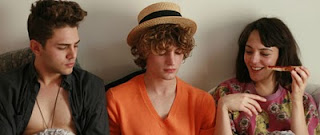Amours Imaginaires - Heartbeats
By Moira Sullivan
French Canadian Xavier Dolan’s narrative with a documentary edge, Heartbeats, begins with a quote by the 19th century French poet Alfred Musset: there is a real world that reasons about love. (Il n’ya a de vrai au monde que d´raissoner d’amour). The original French title is Amours Imaginaires - Imaginary Lovers. The English title has no meaning for the premise of the film, as we shall see.
Heartbeats is an interesting film with an inventive and imaginative use of the camera. In the opening minutes, three young people speak about love while the camera changes focal lengths with abrupt close-ups and pull backs. It is not the last time this will happen.
The camera work in itself is worthy of investigation and the way Dolan frames his subjects. The film is made from a rich HD color film stock. It cost 7 million dollars to make and was selected for last years Cannes Film Festival fortnight section and last fall’s Mill Valley Film Festival. And it is now opening in San Francisco.
This is Dolan’s second feature. Three people—not the ones interviewed in the beginning, - Francis, Marie and Nicolas are played by Xavier Dolan, himself Monia Chokri, and Niels Schneider. They engage in what does not seem so much as a reasonable encounter with love but a very bizarre one wrought with tension and power struggles. We really never get to follow this chronologically. In one scene Francis discovers a rabbit in the forest only to be pounced on by Nicolas. Marie makes faces, and Francis makes screeching sounds when Nicolas is nearby. You kind of get to hate pretty Nicolas somehow.
The film doesn’t have so much of a story as a story like backdrop with a lot of posing, which includes many shots of Dolan’s Eraser head like hairdo from another decade.
There are pure cinematic moments to the film, which demand nothing of us but just laying back and watching the panorama of sound and image enfold. For example while a version of Sonny Bono’s song Bang Bang plays in the background sung by Dalida, Marie saunters down the street in a tight purple dress in slow motion.
The Swedish group The Knife also contributes to the soundtrack.
The Swedish group The Knife also contributes to the soundtrack.
Other scenes include meeting at the opening of a play called "Migraine and "Sonatas", then back to interviews with several other young people speaking about love
The relationship between Francis and Nicolas is homoerotic but it is Marie who gets the first onscreen sex scene with another boy shot in red.
Xavier in green screen is shown with another man; the second sex scene is much tamer. Another scene in blue screen completes the sequences of physical love. The three sex scenes serve as artistic backdrops, which are unconnected to the so-called love triangle. After a rather long party scene the three imaginary lovers are shown sleeping in the same bed. How they got there, we don’t know-
As is customary in a French language treatment of love, the obligatory violoncello solo Suite no 1 by Bach hums in the background. With a lot of smoking, drinking eating - and coffee.
© 2011 - Moira Sullivan - Air Date: 03/16/11
Movie Magazine International
Movie Magazine International

Comments
Post a Comment